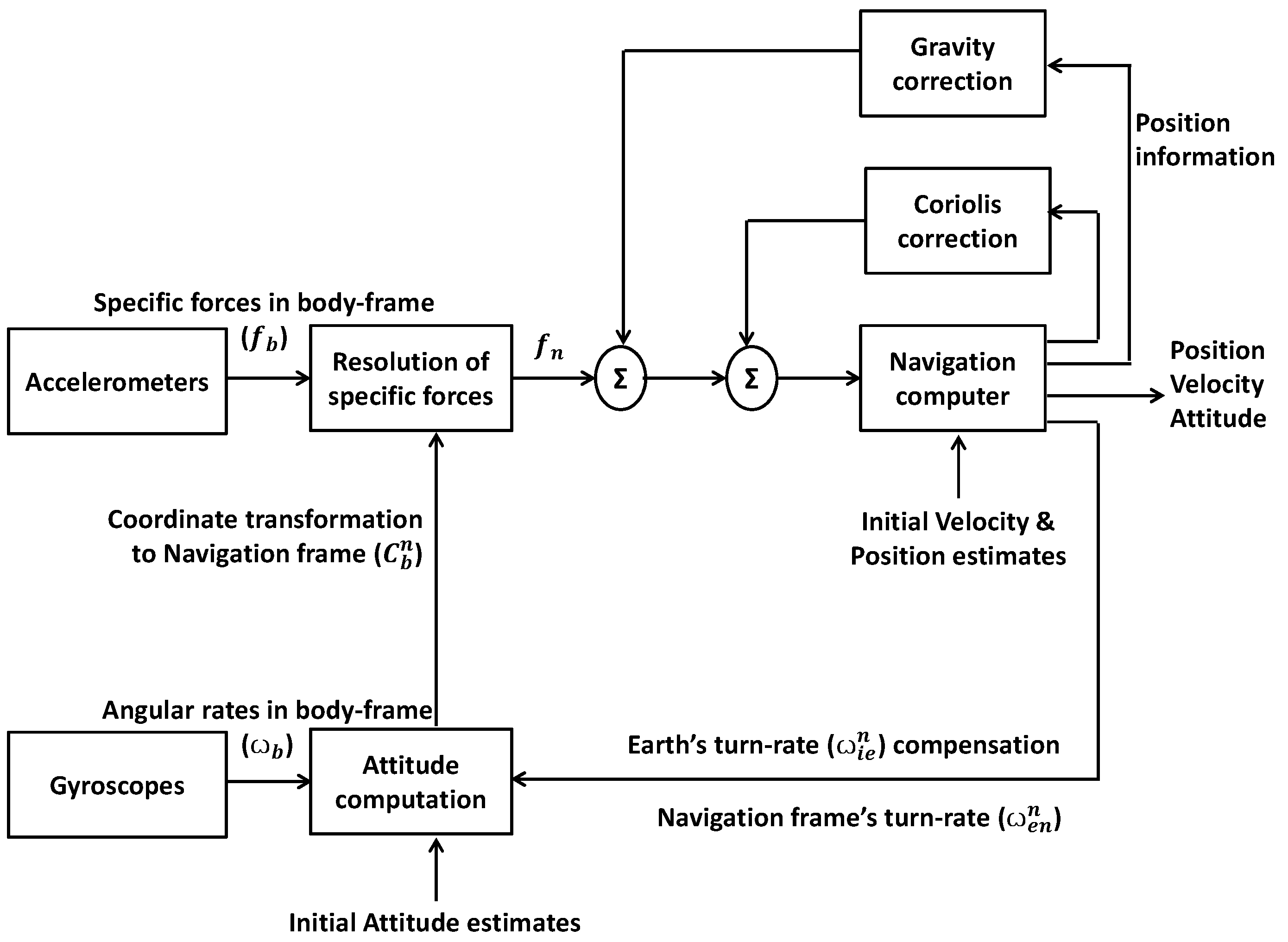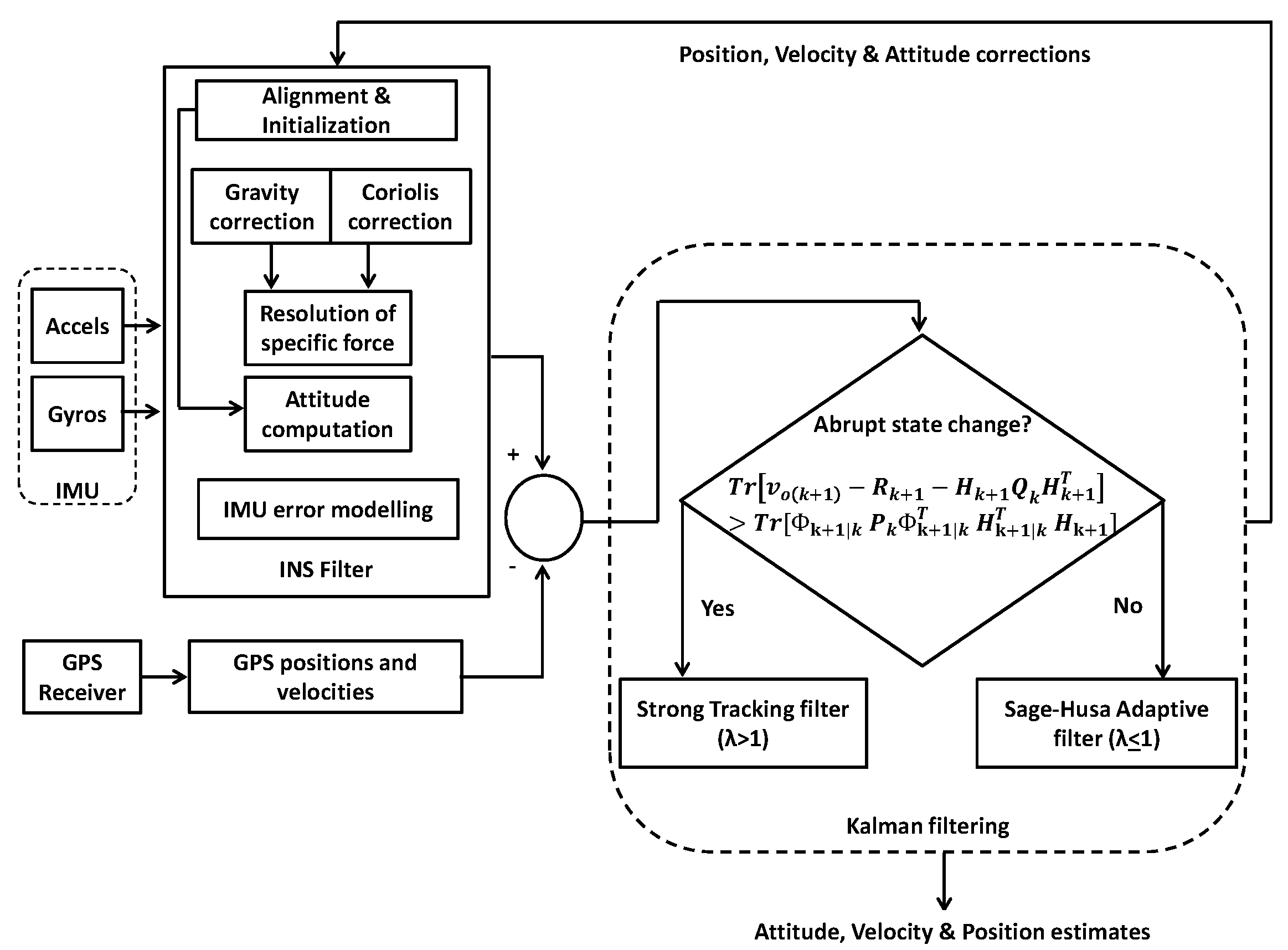Adaptive Filtering on GPS-Aided MEMS-IMU for Optimal Estimation of Ground Vehicle Trajectory
Abstract
:1. Introduction
2. Inertial Navigation Mechanism
3. Filtering
3.1. Conventional Kalman Filter
3.2. Adaptive Kalman Filtering
3.2.1. Sage-Husa Adaptive Kalman Filter
3.2.2. Strong Tracking Robust Kalman Filter
4. Proposed Scheme
Mathematical Model
5. Simulation, Data Collection and Results
6. Conclusions
Author Contributions
Funding
Conflicts of Interest
References
- Choi, E.; Chang, S. A consumer tracking estimator for vehicles in GPS-free environments. IEEE Trans. Consum. Electron. 2017, 63, 450–458. [Google Scholar] [CrossRef]
- Bevly, D.M.; Parkinson, B. Cascaded Kalman filters for accurate estimation of multiple biases, dead-reckoning navigation, and full state feedback control of ground vehicles. IEEE Trans. Control Syst. Technol. 2007, 15, 199–208. [Google Scholar] [CrossRef]
- Kirkko-Jaakkola, M.; Collin, J.; Ta, J. Bias prediction for MEMS gyroscopes. IEEE Sens. J. 2012, 12, 2157–2163. [Google Scholar] [CrossRef]
- Savage, P. Strapdown Analytics, Part 1; Strapdown: Maple Plain, MN, USA, 2007. [Google Scholar]
- Perera, L.D.; Wijesoma, W.S.; Adams, M.D. The estimation theoretic sensor bias correction problem in map aided localization. Int. J. Robot. Res. 2006, 25, 645–667. [Google Scholar] [CrossRef]
- Atia, M.M.; Liu, S.; Nematallah, H.; Karamat, T.B.; Noureldin, A. Integrated indoor navigation system for ground vehicles with automatic 3-D alignment and position initialization. IEEE Trans. Veh. Technol. 2006, 64, 1279–1292. [Google Scholar] [CrossRef]
- Salmon, D.C.; Bevly, D.M. An Exploration of Low-cost Sensor and Vehicle Model Solutions for Ground Vehicle Navigation. In Proceedings of the IEEE/ION Position, Location and Navigation Symposium-PLANS 2014, Monterey, CA, USA, 5–8 May 2014. [Google Scholar]
- Tahir, Z.; Qureshi, A.; Ayaz, Y.; Nawaz, R. Potentially guided bidirectionalized RRT* for fast optimal path planning in cluttered environments. Robot. Auton. Syst. 2018, 108, 13–27. [Google Scholar] [CrossRef] [Green Version]
- Sukkarieh, S.; Nebot, E.M.; Durrant-Whyte, H.F. Achieving integrity in an INS/GPS navigation loop for autonomous land vehicle applications. In Proceedings of the 1998 IEEE International Conference on Robotics and Automation, Leuven, Belgium, 20–20 May 1998; Volume 4, pp. 3437–3442. [Google Scholar] [CrossRef] [Green Version]
- Rose, C.; Britt, J.; Allen, J.; Bevly, D. An Integrated Vehicle Navigation System Utilizing Lane-detection and Lateral Position Estimation Systems in Difficult Environments for GPS. IEEE Trans. Intell. Transp. Syst. 2014, 15, 2615–2629. [Google Scholar] [CrossRef]
- Qadir, H.; Khalid, O.; Khan, M.; Khan, A.; Nawaz, R. An Optimal Ride Sharing Recommendation Framework for Carpooling Services. IEEE Access 2018, 6, 62296–62313. [Google Scholar] [CrossRef]
- Ayyaz, S.; Qamar, U.; Nawaz, R. HCF-CRS: A Hybrid Content based Fuzzy Conformal Recommender System for providing recommendations with confidence. PLoS ONE 2018, 13, e0204849. [Google Scholar] [CrossRef] [Green Version]
- Godha, S.; Cannon, M.E. Integration of DGPS with a low cost MEMS-based inertial measurement unit (IMU) for land vehicle navigation application. In Proceedings of the 18th International Technical Meeting of the Satellite Division of the Institute of Navigation, Long Beach, CA, USA, 13–16 September 2005; pp. 333–345. [Google Scholar]
- Zhao, S.; Chen, Y.; Farrell, J.A. High-precision Vehicle Navigation in Urban Environments Using an MEM’s IMU and Single-frequency GPS Receiver. IEEE Trans. Intell. Transp. Syst. 2016, 17, 2854–2867. [Google Scholar] [CrossRef]
- Schmidt, G.T. Navigation Sensors and Systems in GNSS Degraded and Denied Environments. Chin. J. Aeronaut. 2015, 28, 1–10. [Google Scholar] [CrossRef] [Green Version]
- Grewal, M.S.; Andrews, A.P.; Bartone, C.G. Global Navigation Satellite Systems, Inertial Navigation, and Integration, 3rd ed.; Wiley-Interscience: New York, NY, USA, 2013. [Google Scholar]
- Nisar, S.; Ullah, I. Non-linear filtering techniques for high precision GPS applications. In Proceedings of the 2017 International Conference on Communication, Computing and Digital Systems, Islamabad, Pakistan, 8–9 March 2017; pp. 276–280. [Google Scholar] [CrossRef]
- Chen, Z.; Qu, Y.; Ling, X.; Li, Y.; Jiao, H.; Liu, Y. Study on GPS/INS loose and tight coupling. In Proceedings of the 7th International Conference on Intelligent Human-Machine Systems and Cybernetics, Jiangyin, China, 26–27 August 2015. [Google Scholar]
- El-Diasty, M.; Pagiatakis, S. An efficient INS/GPS impulse response model for bridging GPS outages. In Proceedings of the 2009 IEEE Toronto International Conference Science and Technology for Humanity (TIC-STH), Toronto, ON, Canada, 26–27 September 2009. [Google Scholar]
- Crassidis, J.L. Sigma-point Kalman filtering for integrated GPS and inertial navigation. IEEE Trans. Aerosp. Electron. Syst. 2006, 42, 750–756. [Google Scholar] [CrossRef]
- Gupta, M. The Strong Tracking Augmented Kalman Filter for Satellite Attitude Determination. Int. J. Adv. Res. Sci. Eng. 2014, 3, 171–180. [Google Scholar]
- Karlgaard, C.D.; Shen, H. Desensitised Kalman filtering. IET Radar Sonar Navig. 2013, 7, 2–9. [Google Scholar] [CrossRef]
- Zanetti, R.; Bishop, R.H. Kalman filters with uncompensated biases. J. Guid. Control Dyn. 2012, 35, 327–335. [Google Scholar] [CrossRef]
- Zheng, B.; Fu, P.; Li, B.; Yuan, X. A robust adaptive unscented Kalman filter for nonlinear estimation with uncertain noise covariance. Sensors 2018, 18, 808. [Google Scholar] [CrossRef] [Green Version]
- Ding, W.; Wang, J.; Rizos, C. Improving adaptive Kalman estimaion in GPS/INS integration. J. Navig. 2007, 60, 517–529. [Google Scholar] [CrossRef] [Green Version]
- Jaradat, M.A.K.; Abdel-Hafez, M.F. Enhanced, Delay Dependent, Intelligent Fusion for INS/GPS Navigation System. IEEE Sens. J. 2014, 14, 1545–1554. [Google Scholar] [CrossRef]
- Ge, Q.; Shao, T.; Wen, C.; Sun, R. Analysis on strong tracking filtering for linear dynamic systems. Math. Probl. Eng. 2015, 2015, 648125. [Google Scholar] [CrossRef]
- Sage, A.P.; Husa, G.W. Adaptive filtering with unknown prior statistics. IEEE Trans. Autom. Control 1969, 7, 760–769. [Google Scholar]
- Sun, F.; Zhang, H. Application of a new adaptive Kalman filtering algorithm in initial alignment of INS. In Proceedings of the 2011 IEEE International Conference on Mechatronics and Automation, Beijing, China, 7–10 August 2011. [Google Scholar]
- Zhou, D.H.; Xi, Y.G.; Zhang, Z.J. A suboptimal multiple fading extended Kalman filter. Chin. J. Autom. 1991, 4, 145–152. [Google Scholar]
- Titterton, D.; Weston, J. Strapdown Inertial Navigation Technology, 2nd ed.; The Institution of Engineering and Technology: London, UK, 2005. [Google Scholar]
















| Parameter | Gyro | Accelerometer |
|---|---|---|
| Bias Repeatability | <0.02/s, 1 | <2 mg, 1 |
| Random Walk | <6/hr | <0.3 m/s2/hr |
| Scale Factor Stability | <0.3%, 1 | <0.2%, 1 |
| Bias Variation | <0.1/s, 1 | <5 mg, 1 |
| Bandwidth | >100 Hz, Gain @ dB | >100 Hz, Gain @ −3 dB |
© 2019 by the authors. Licensee MDPI, Basel, Switzerland. This article is an open access article distributed under the terms and conditions of the Creative Commons Attribution (CC BY) license (http://creativecommons.org/licenses/by/4.0/).
Share and Cite
Ahmed, H.; Ullah, I.; Khan, U.; Qureshi, M.B.; Manzoor, S.; Muhammad, N.; Shahid Khan, M.U.; Nawaz, R. Adaptive Filtering on GPS-Aided MEMS-IMU for Optimal Estimation of Ground Vehicle Trajectory. Sensors 2019, 19, 5357. https://doi.org/10.3390/s19245357
Ahmed H, Ullah I, Khan U, Qureshi MB, Manzoor S, Muhammad N, Shahid Khan MU, Nawaz R. Adaptive Filtering on GPS-Aided MEMS-IMU for Optimal Estimation of Ground Vehicle Trajectory. Sensors. 2019; 19(24):5357. https://doi.org/10.3390/s19245357
Chicago/Turabian StyleAhmed, Haseeb, Ihsan Ullah, Uzair Khan, Muhammad Bilal Qureshi, Sajjad Manzoor, Nazeer Muhammad, Muhammad Usman Shahid Khan, and Raheel Nawaz. 2019. "Adaptive Filtering on GPS-Aided MEMS-IMU for Optimal Estimation of Ground Vehicle Trajectory" Sensors 19, no. 24: 5357. https://doi.org/10.3390/s19245357
APA StyleAhmed, H., Ullah, I., Khan, U., Qureshi, M. B., Manzoor, S., Muhammad, N., Shahid Khan, M. U., & Nawaz, R. (2019). Adaptive Filtering on GPS-Aided MEMS-IMU for Optimal Estimation of Ground Vehicle Trajectory. Sensors, 19(24), 5357. https://doi.org/10.3390/s19245357









